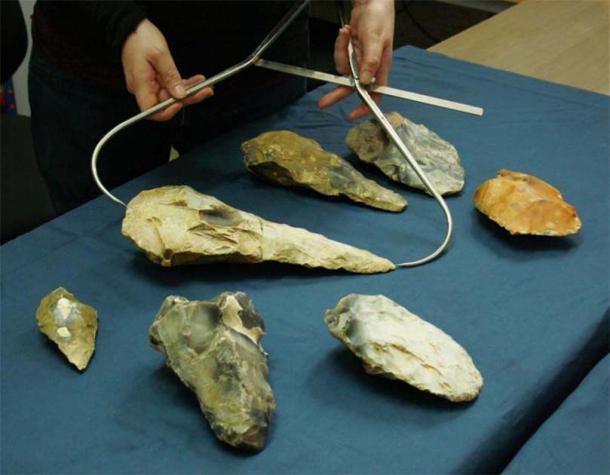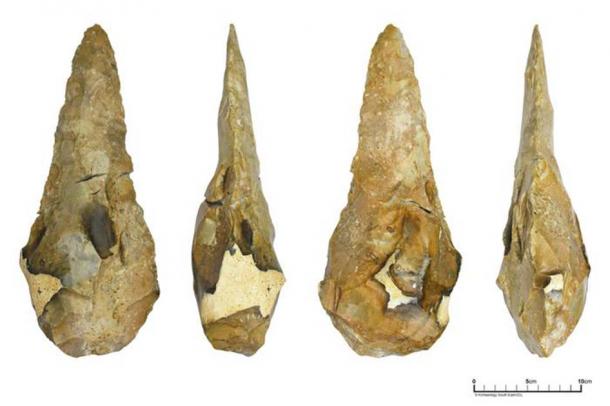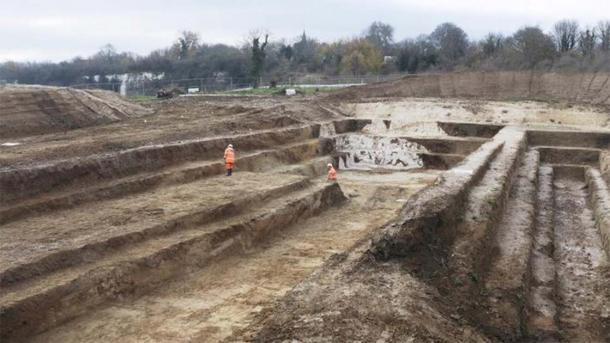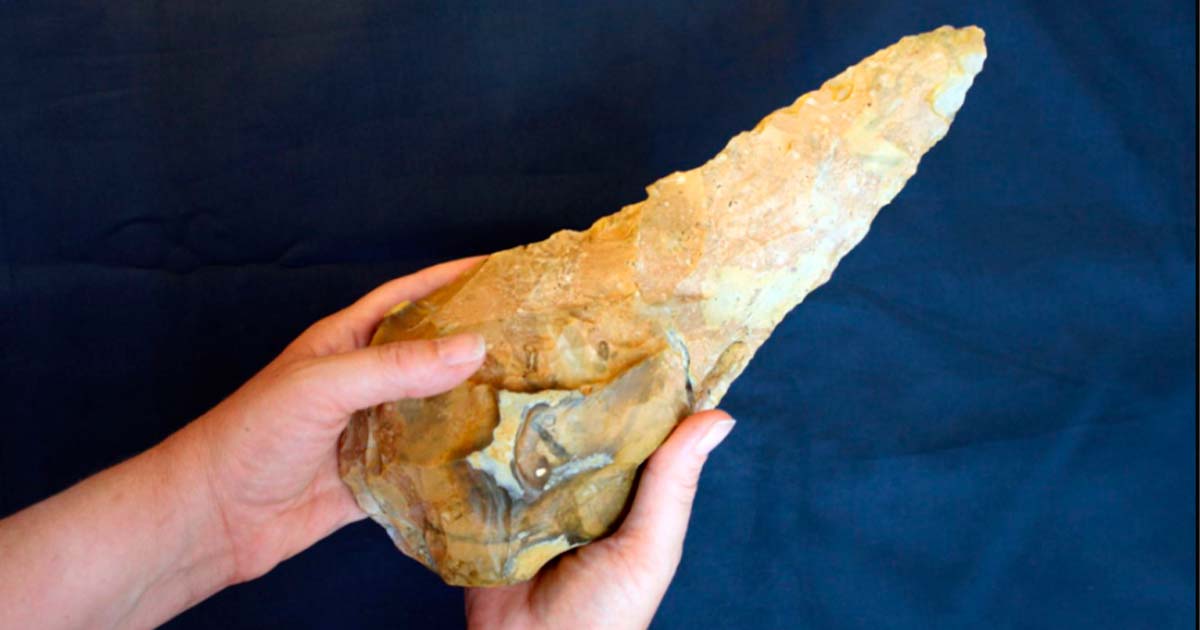Giant Handaxes Are Among Largest Prehistoric Stone Tools Ever Unearthed in Britain
Researchers from the UCL Institute of Archaeology have discovered some of the largest ever prehistoric stone tools unearthed in Britain. A thorough excavation conducted in Kent unveiled ancient artifacts dating back over 300,000 years, which includes approximately 800 stone objects, found within deep Ice Age sediment. Of particular interest among the unearthed artifacts were two exceptionally large flint knives referred to as "giant handaxes”!
The excavation of a hillside above the Medway Valley, Kent ahead of the development of the Maritime Academy School in Frindsbury, was conducted by UCL Archaeology South-East, and has been published in the journal Internet Archaeology. They were found buried in material which filled a sinkhole and an ancient river channel.
- Resourceful and Intelligent Hominins Flourished in Arabia Using “Old School” Stone Tools
- New Insights into Rapid Advance in Human Innovative Thinking

ASE Senior Archaeologist Letty Ingrey measures the largest giant handaxe. (Archaeology South-East/ UCL)
Massive Finds: Giant Handaxes, Unknown Functionality
The huge handaxes are stone tools crafted by chipping both sides to create a symmetrical shape with a long cutting edge. It is believed that these tools were primarily used for butchering animals and cutting meat. The two largest handaxes discovered at the site exhibit distinctive characteristics, such as a long, finely worked pointed tip and a significantly thicker base, according to a press release.
Letty Ingrey, Senior Archaeologist at the UCL Institute of Archaeology, said:
"We describe these tools as giants when they are over 22cm long, and we have two in this size range. The biggest, a colossal 29.5cm in length, is one of the longest ever found in Britain. These handaxes are so big it's difficult to imagine how they could have been easily held and used. Right now, we aren't sure why such large tools were being made, or which species of early human were making them. This site offers a chance to answer these exciting questions."
Such giant handaxes are typically found in the Thames and Medway regions and date back over 300,000 years. The sheer size of these handaxes poses a challenge in envisioning how they could have been easily held and used. It is possible that these tools served a more symbolic or less practical function, showcasing strength and skill.
- The Stone Age: The First 99 Percent of Human History
- Study finds ancient humans butchered elephants with stone tools 500,000 years ago

The largest giant handaxe, 29.5cm or 11.6 inches long. (Archaeology South-East/ UCL)
The exact reasons for the production of such large tools and the identity of the early human species responsible for their creation remain uncertain, though the site also offers the possibilities of answering some of these crucial questions.
Medway Valley: A Hotbed of Historical Finds
Medway Valley at this time was likely a wild landscape characterized by wooded hills and river valleys, providing a home to various animals such as red deer, horses, as well as now-extinct species like the straight-tusked elephant and lion. In this phase of early British prehistory, Neanderthals and their cultures were emerging and potentially coexisting with other early human species, reports The BBC.
Dr Matt Pope (UCL Institute of Archaeology), said:
“The excavations at the Maritime Academy have given us an incredibly valuable opportunity to study how an entire Ice Age landscape developed over a quarter of a million years ago. A program of scientific analysis, involving specialists from UCL and other UK institutions, will now help us to understand why the site was important to ancient people and how the stone artifacts, including the ‘giant handaxes’ helped them adapt to the challenges of Ice Age environments.”
Furthermore, the team has made an additional noteworthy discovery at the site—a Roman cemetery dating to a period at least 250,000 years after the Ice Age activity. Senior Archaeologist Giles Dawkes, also affiliated with the UCL Institute of Archaeology, is leading the study of this find.

Extensive excavations at the site have thrown up exciting discoveries at the Maritime Academy School site in Frindsbury. (Archaeology South-East/ UCL)
The cemetery contains the remains of 25 individuals, with 13 of them cremated. Some of the buried individuals were interred with personal items, including bracelets, and four were laid to rest in wooden coffins. Nearby collections of pottery and animal bones suggest the presence of feasting rituals during the burial ceremonies!
While extensive excavations of Roman structures have been conducted, Roman cemeteries have received less attention in archaeological research. The discovery of this site presents a unique opportunity to gain new insights into the burial customs and traditions of both the inhabitants of the nearby town of Rochester and the Romans associated with the villa believed to have existed around 850 meters (930 yards) to the south.
"We, at Maritime Academy and the Thinking Schools Academy Trust, feel very lucky to be a part of this phenomenal discovery. We take great pride in our connection to our local community and region, with much of our school identity linked to the history of Medway. We look forward to taking advantage of this unique opportunity to teach our young people about these finds, creating a lasting legacy for those who came before us,” concluded Jody Murphy, Director of Education at the Thinking Schools Academy Trust.
Top image: The largest giant handaxe found at the Maritime Academy School site in Frindsbury, Kent, UK. Source: Ingrey et al/Internet Archaeology
By Sahir Pandey
References
Fuller, C. 2023. Giant stone artefacts found on rare Ice Age site in Kent. Available at: https://www.bbc.com/news/uk-england-kent-66112136.
Ingrey, L., Duffy, SM., Bates, M., Shaw, A. and Pope, M. 2023. On the Discovery of a Late Acheulean 'Giant' Handaxe from the Maritime Academy, Frindsbury, Kent. Internet Archaeology, 61. Available at: https://doi.org/10.11141/ia.61.6.
Milligan, M. 2023. 300,000 YEAR OLD “GIANT” PREHISTORIC HANDAXES FOUND IN KENT. Available at: https://www.heritagedaily.com/2023/07/300000-year-old-giant-prehistoric-handaxes-found-in-kent/147948.

















